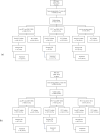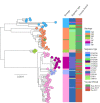A Streptococcus pneumoniae lineage usually associated with pneumococcal conjugate vaccine (PCV) serotypes is the most common cause of serotype 35B invasive disease in South Africa, following routine use of PCV
- PMID: 35384831
- PMCID: PMC9453074
- DOI: 10.1099/mgen.0.000746
A Streptococcus pneumoniae lineage usually associated with pneumococcal conjugate vaccine (PCV) serotypes is the most common cause of serotype 35B invasive disease in South Africa, following routine use of PCV
Abstract
Pneumococcal serotype 35B is an important non-conjugate vaccine (non-PCV) serotype. Its continued emergence, post-PCV7 in the USA, was associated with expansion of a pre-existing 35B clone (clonal complex [CC] 558) along with post-PCV13 emergence of a non-35B clone previously associated with PCV serotypes (CC156). This study describes lineages circulating among 35B isolates in South Africa before and after PCV introduction. We also compared 35B isolates belonging to a predominant 35B lineage in South Africa (GPSC5), with isolates belonging to the same lineage in other parts of the world. Serotype 35B isolates that caused invasive pneumococcal disease in South Africa in 2005-2014 were characterized by whole-genome sequencing (WGS). Multi-locus sequence types and global pneumococcal sequence clusters (GPSCs) were derived from WGS data of 63 35B isolates obtained in 2005-2014. A total of 262 isolates that belong to GPSC5 (115 isolates from South Africa and 147 from other countries) that were sequenced as part of the global pneumococcal sequencing (GPS) project were included for comparison. Serotype 35B isolates from South Africa were differentiated into seven GPSCs and GPSC5 was most common (49 %, 31/63). While 35B was the most common serotype among GPSC5/CC172 isolates in South Africa during the PCV13 period (66 %, 29/44), 23F was the most common serotype during both the pre-PCV (80 %, 37/46) and PCV7 period (32 %, 8/25). Serotype 35B represented 15 % (40/262) of GPSC5 isolates within the global GPS database and 75 % (31/40) were from South Africa. The predominance of the GPSC5 lineage within non-vaccine serotype 35B, is possibly unique to South Africa and warrants further molecular surveillance of pneumococci.
Keywords: South Africa; Streptococcus pneumoniae; global pneumococcal sequence cluster; serotype 35B.
Conflict of interest statement
Professor Anne von Gottberg and Dr Mignon du Plessis received funding from Pfizer Vaccines Research and Sanofi Pasteur. Dr Gladstone reports PhD studentship from Pfizer outside the submitted work (2009–2012). The other authors declare that they have no conflicts of interest directly relating to this manuscript.
Figures





References
-
- Ndlangisa KM, du Plessis M, Lo S, de Gouveia L, Chaguza C, et al. A Streptococcus pneumoniae lineage usually associated with pneumococcal conjugate vaccine (PCV) serotypes is the most common cause of serotype 35B invasive disease in South Africa, following routine use of PCV. Figshare. 2022. DOI: 10.6084/m9.figshare.16621984 - PMC - PubMed
-
- Tyrrell GJ, Lovgren M, Chui N, Minion J, Garg S, et al. Serotypes and antimicrobial susceptibilities of invasive Streptococcus pneumoniae pre- and post-seven valent pneumococcal conjugate vaccine introduction in Alberta, Canada, 2000-2006. Vaccine. 2009;27:3553–3560. doi: 10.1016/j.vaccine.2009.03.063. - DOI - PubMed
Publication types
MeSH terms
Substances
Associated data
Grants and funding
LinkOut - more resources
Full Text Sources
Medical

